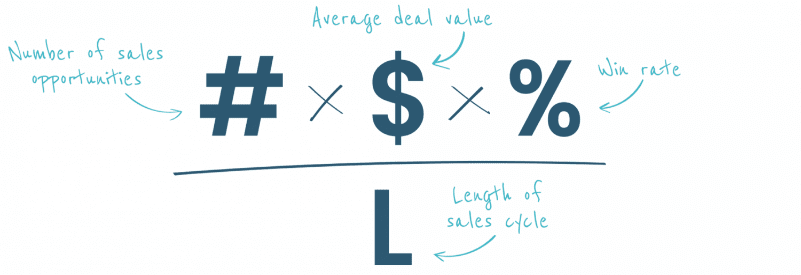Chefs and B2B sales professionals have a lot in common. The best ones develop their techniques to improve their performance. Here is one set of strikingly parallel questions for the chef and the sales rep:
 For the chef: How do you boil a live lobster?
For the chef: How do you boil a live lobster?
For the sales rep: How do you introduce quantitative value into a customer conversation?
There are two primary approaches to each question.
- Throw the lobsters into rapidly boiling water. They emit a piercing, screaming sound. Some hear those sounds as shrieks of pain. In New Zealand, Switzerland, and parts of Italy, cooking live lobsters is against the law.
 Yet boiling lobsters live, a practice recorded in Roman times, is not going away. Maine experts say don’t worry, those aren’t screams – lobsters don’t have vocal chords. The sound coming from the lobster pot is the air coming out of their stomachs through their mouth parts. Lobsters don’t have a brain, they argue, and lack the neural anatomy to feel pain. Head first into boiling water makes for a memorable dining experience.
Yet boiling lobsters live, a practice recorded in Roman times, is not going away. Maine experts say don’t worry, those aren’t screams – lobsters don’t have vocal chords. The sound coming from the lobster pot is the air coming out of their stomachs through their mouth parts. Lobsters don’t have a brain, they argue, and lack the neural anatomy to feel pain. Head first into boiling water makes for a memorable dining experience.
 Start a customer value conversation by plunging in. “Tell them what you are going to say, say it, then tell them what you’ve said.” This ubiquitous presentation advice has a long pedigree, attributed to many including Aristotle and Dale Carnegie. When it comes to value conversations, there is a benefit to starting with total impact, total value, or the bottom line. There is not much chance that your audience will misunderstand the point of the conversation and where you are headed.
Start a customer value conversation by plunging in. “Tell them what you are going to say, say it, then tell them what you’ve said.” This ubiquitous presentation advice has a long pedigree, attributed to many including Aristotle and Dale Carnegie. When it comes to value conversations, there is a benefit to starting with total impact, total value, or the bottom line. There is not much chance that your audience will misunderstand the point of the conversation and where you are headed.
 Starting with a key financial number is natural in a customer meeting set up specifically to quantify or present value. With a product manager, a member of the value office, a subject matter expert, or some other presales professional in the meeting, it will come as no surprise that the agenda includes the financial value of outcomes. “Based on our understanding of your business, we believe that switching to our solution will save you $1.5 million a year. Now let’s see how we arrive at this estimate.”
Starting with a key financial number is natural in a customer meeting set up specifically to quantify or present value. With a product manager, a member of the value office, a subject matter expert, or some other presales professional in the meeting, it will come as no surprise that the agenda includes the financial value of outcomes. “Based on our understanding of your business, we believe that switching to our solution will save you $1.5 million a year. Now let’s see how we arrive at this estimate.”
A statement like this, well prepared and made with confidence, definitely focuses the meeting. But a meeting with a presales professional in the physical or virtual room is likely to be in the middle or later in a sales process: (i) when the customer is already actively engaged in evaluating or purchasing our solution, and (ii) when our sales team may already know something about the customer’s business problems and the outcomes the customer is seeking to achieve by purchasing our solution.
 When the value statement is unexpected and comes, perhaps awkwardly, from a member of the sales team other than the rep or account manager, the sales rep has plenty of ways to recover during and after the meeting. Reps with highly attuned antennae, sometimes find a colleague’s claim of financial results to be cringeworthy, not because the rep doesn’t understand them, but because the rep perceives them to be unsubtle, pushy, or potentially offensive. If the customer responds badly to the financial conversation, the sales rep can redirect the conversation to another topic or have a side conversation after the meeting to smooth ruffled feathers. Often enough, just as the sales rep is sitting on the sideline cringing, the customer is actually engaged in a value discussion with their presales colleague. The meeting turns out better than the rep anticipated. There is no mess to clean up. The sales cycle accelerates and the rep closes the deal. But the rep didn’t take the risk to plunge in. The presales professional did.
When the value statement is unexpected and comes, perhaps awkwardly, from a member of the sales team other than the rep or account manager, the sales rep has plenty of ways to recover during and after the meeting. Reps with highly attuned antennae, sometimes find a colleague’s claim of financial results to be cringeworthy, not because the rep doesn’t understand them, but because the rep perceives them to be unsubtle, pushy, or potentially offensive. If the customer responds badly to the financial conversation, the sales rep can redirect the conversation to another topic or have a side conversation after the meeting to smooth ruffled feathers. Often enough, just as the sales rep is sitting on the sideline cringing, the customer is actually engaged in a value discussion with their presales colleague. The meeting turns out better than the rep anticipated. There is no mess to clean up. The sales cycle accelerates and the rep closes the deal. But the rep didn’t take the risk to plunge in. The presales professional did.
 The simple fact is that plunging into a value conversation is often an uncomfortable experience for a sales rep flying solo and unaccustomed to talking about value. They are often concerned: (i) that talking dollars is too direct or is somehow offensive in a way that will lead to blowback later, (ii) that they will be called out for making the wrong assumptions about their customer, or (iii) that they will not be able to defend the math behind the numbers that the customer sees. Going straight to value takes confidence and courage. The average sales rep sometimes finds both in short supply.
The simple fact is that plunging into a value conversation is often an uncomfortable experience for a sales rep flying solo and unaccustomed to talking about value. They are often concerned: (i) that talking dollars is too direct or is somehow offensive in a way that will lead to blowback later, (ii) that they will be called out for making the wrong assumptions about their customer, or (iii) that they will not be able to defend the math behind the numbers that the customer sees. Going straight to value takes confidence and courage. The average sales rep sometimes finds both in short supply.
 This is exactly why driving conversations directly to value is an important step to take for the average rep. It is a new type of conversation where being tentative or defensive is unlikely to be effective in delivering results. But it is a new type of conversation that closes more deals at higher prices. Changing the conversation is seldom easy but improved results provide the incentive. Introducing value doesn’t require winning the value argument in the first meeting. It works by implanting a vision of value with the buyer that can become a basis for follow-up, deeper engagement, and evaluation.
This is exactly why driving conversations directly to value is an important step to take for the average rep. It is a new type of conversation where being tentative or defensive is unlikely to be effective in delivering results. But it is a new type of conversation that closes more deals at higher prices. Changing the conversation is seldom easy but improved results provide the incentive. Introducing value doesn’t require winning the value argument in the first meeting. It works by implanting a vision of value with the buyer that can become a basis for follow-up, deeper engagement, and evaluation.
Our Vice President of Sales at LeveragePoint, Brian Hannon, is a firm believer of plunging into value conversations, especially early in the sales cycle. Getting directly to value invites, and sometimes forces, customer engagement. It helps Brian understand quickly what a prospect’s challenges are. It helps him qualify the account as a reasonable opportunity or a likely dead-end. Direct value conversations challenge the customer, increasing sales velocity.
To be clear, Brian’s value conversations are more than one-line assertions of value. He shows a few assumptions to get the customer talking. He draws attention to a few key claims and usually adjusts them downwards to be conservative. He is ready to talk about where the math comes from, although he avoids getting bogged down in a math discussion. But Brian plunges into value early in the sales cycle because he knows that talking about value improves performance.  Place the lobsters in cold water. Gradually warm to a boil. There is another way to boil a live lobster. Bertha Nunan, owner of the Lobster Hut in Cape Porpoise, Maine, where she served 700 pounds of lobster a night, had a kinder, gentler approach. “The secret to cooking lobsters is not to murder them. Give them a nice, slow, respectable way out. Don’t put them in boiling water, and don’t drown them in too much water.”
Place the lobsters in cold water. Gradually warm to a boil. There is another way to boil a live lobster. Bertha Nunan, owner of the Lobster Hut in Cape Porpoise, Maine, where she served 700 pounds of lobster a night, had a kinder, gentler approach. “The secret to cooking lobsters is not to murder them. Give them a nice, slow, respectable way out. Don’t put them in boiling water, and don’t drown them in too much water.”
The first time I boiled lobsters, I asked my next door neighbor, a hardened veteran of backyard lobster feasts, how he did it. Although he was doubtless a “head first in the pot” lobster chef, he knew he was talking to a squeamish amateur. “If you don’t want ‘em thrashin’ and splashin’ all over your deck, warm them up gently – they just go to sleep,” he said, reaching for a Bud Light. After a five-minute lesson, he had me believing I could serve lobster to a vegan.
Warm up gradually to the value conversation. When first confronted with the financial part of a value proposition, some sales reps don’t know what to do. How do they start the conversation? How do they tell the story to get to a value endpoint? If they are asking these questions, it is both good news and bad news. The good news is that they are engaged, trying to work through how they will have the value conversation, considering which customers they want to try it on. The bad news is that their hesitation probably reflects at least one of three attitudes or temptations: “I am insecure without product and company information at the start of a presentation.” Too much product is the problem with sales calls today. Sales reps talk about product features, not about customer outcomes. Buying executives say repeatedly that sales meetings are unproductive because they are too focused on the vendor’s company and product and not sufficiently focused on the buyer’s business problems and how they can solve them.
“I am insecure without product and company information at the start of a presentation.” Too much product is the problem with sales calls today. Sales reps talk about product features, not about customer outcomes. Buying executives say repeatedly that sales meetings are unproductive because they are too focused on the vendor’s company and product and not sufficiently focused on the buyer’s business problems and how they can solve them.
The big reason to switch the conversation to a value conversation is to drive customer-centric engagement with the buyer early in the sales cycle. Adding a lot of product material as a lead-in to the value discussion is likely to re-enforce old, product-centric sales habits. Comforted by familiar product material, the sales rep never adjusts their game to initiating the value conversation, ending the meeting in the middle of the content and putting value off until later. “I need to get the customer data right before I talk about value.” This is the oldest excuse in the book for not discussing value. It often reveals a lack of sales confidence to try something new. Unfortunately, it finds support in a number of sales methodologies that call for consultative selling, often based on a substantial playbook for discovery.
“I need to get the customer data right before I talk about value.” This is the oldest excuse in the book for not discussing value. It often reveals a lack of sales confidence to try something new. Unfortunately, it finds support in a number of sales methodologies that call for consultative selling, often based on a substantial playbook for discovery.
Value Propositions that succumb to this instinct often drown the customer in discovery. This is a bad way to embed value conversations early in the sales cycle. Few prospects are willing to provide a lot of information before they have decided to invest time and bandwidth in evaluating a solution. The data do not have to be perfect to have an effective value conversation. Get first time value sellers to practice. Let them ride along with an experienced value seller. Show videos of other reps making real or simulated value presentations. “I need a value story that builds to a dramatic conclusion.” We all know sales people who are great story tellers. They understand how to get an audience engaged, laying out an amusing narrative that leads, by way of surprise twists, to a dramatic, memorable conclusion. It is natural to want to capture this approach and replicate it. In a Value Proposition, that usually means a lead-in, followed by significant discovery, followed by piecemeal arguments, a value driver at a time, before revealing the dramatic conclusion. “So, with all these proven sources of value, we estimate that you can save $2.5 million.”
“I need a value story that builds to a dramatic conclusion.” We all know sales people who are great story tellers. They understand how to get an audience engaged, laying out an amusing narrative that leads, by way of surprise twists, to a dramatic, memorable conclusion. It is natural to want to capture this approach and replicate it. In a Value Proposition, that usually means a lead-in, followed by significant discovery, followed by piecemeal arguments, a value driver at a time, before revealing the dramatic conclusion. “So, with all these proven sources of value, we estimate that you can save $2.5 million.”
Building to a dramatic conclusion is a great narrative theory that works well in a movie, but is usually impossible to execute in a business meeting. Executive decision-makers drop in and out of meetings. Other stakeholders divide their attention between the meeting and their mobile devices. Long lead-ins result in stakeholder questions or debate that then result in tangents that defer the memorable conclusion, casting doubt on its premises before the conclusion can be unveiled.
The problem of giving in to one or more of these temptations is that the buyer, like the lobster, goes to sleep before we get to the good part. There is a proven way to warm up to value without too much discovery and without digressing into tangents, debates, or arguments about claims. Instead of starting a value conversation as this customer’s business case to buy our solution, start with the value discussion as a flexible case study of how we delivered value to another comparable customer. Flexible case studies enable sales teams to be specific on outcomes, assumptions, and dollarized value quickly, in a way that sets up a more direct conversation about the business case for this customer to buy our solution. The flexible case study for another customer becomes a business case for this customer to buy.
 Two Approaches to Better Dining. Some sales and presales professionals naturally take to plunging into the deep end, presenting the business case directly. Other reps find it easier to start with a third party case study, gradually transitioning to a business case to buy. Both approaches work. Both approaches can be facilitated in a single Value Proposition. But value selling requires the right content, implementation and mobilization.
Two Approaches to Better Dining. Some sales and presales professionals naturally take to plunging into the deep end, presenting the business case directly. Other reps find it easier to start with a third party case study, gradually transitioning to a business case to buy. Both approaches work. Both approaches can be facilitated in a single Value Proposition. But value selling requires the right content, implementation and mobilization.
 A number of value selling organizations have realized significant impacts on their sales velocity. The formula for sales velocity is simple, highlighting four levers. Value selling has a potential impact on all four of these levers by:
A number of value selling organizations have realized significant impacts on their sales velocity. The formula for sales velocity is simple, highlighting four levers. Value selling has a potential impact on all four of these levers by:
- Increasing qualified opportunities by 10% or more.
- Increasing average deal value by 5 to 25%.
- Increasing win rates by 5 to 15%.
- Shortening sales cycles by 10% or more.
Value selling increases sales velocity by centering customer conversations on the outcomes our solution will deliver to them. Good value selling is neither death by spreadsheet nor is it marketing mush. It is a qualitative, quantitative, and financial conversation centered on the customer’s problems, adapted to customer specifics, that creates a compelling vision of what our solution will deliver to them. That vision includes the dollarized or euro-ized results they can expect.
Implementing value selling successfully requires a few critical initiatives – providing strong Value Proposition content and mobilizing sales are key among them. But the tangible and intangible benefits of driving value selling are worth the investment. And getting members of the sales team to have their first value conversation is a critical first step.

